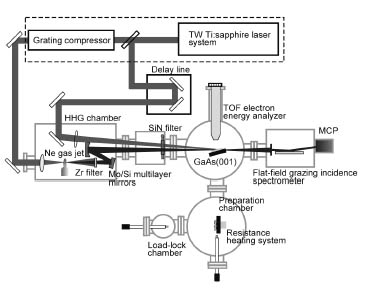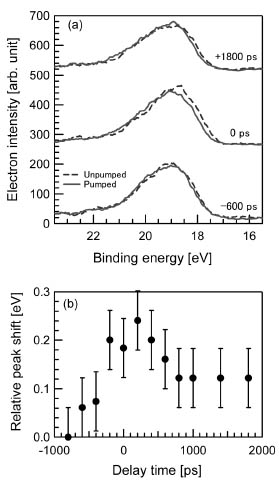Photoelectron Spectroscopy Based on High-Order Harmonic Source
Optical Science Laboratory
High-harmonic generation (HHG) provides an attractive
ultrashort light source of coherent radiation in the extreme-ultraviolet
(EUV) and soft-x-ray regions of the spectrum, which is based on a highly
nonlinear interaction between gaseous atoms and high peak power laser pulse
with intensity of 1013 - 1015 W/cm2 [1]. For the last two decades from the discovery of HHG, the HHG technology has made rapid progress resulting in a unique light source that possesses different characteristics from synchrotron radiation source and x-ray free electron laser. This opens the door to new widely applications of HHG source [2]. We have developed a technique of ultrafast surface photoelectron spectroscopy utilizing three characteristics of HHG including sharp spectral shape, ultrashort pulse duration, and wavelength of surface sensitivity. With this technique, we successfully measured a time-evolution of surface photovoltage effect on photo-excited GaAs(001) surface.
The photoelectron spectroscopy system uses a 100-fs titanium:sapphire laser system with a central wavelength of 790 nm operating at a 10 Hz repetition rate (Fig. 1). We selected the 59th harmonic pulse as the EUV probe by a pair of Mo/Si multilayer mirrors, and measured a photoelectron spectrum of GaAs(001) sample that was chemically etched. When the sample is excited with the laser pulse, we observed an energy shift of Ga 3d-core level photoelectron peak with about 200 meV towards higher binding energy, and its relaxation (Figs. 2(a) and (b)). This indicates that the surface potential changed due to the spatial separation of the electron-hole pair that was generated by the laser excitation, which is called as surface photovoltage (SPV) effect. Improving the temporal resolution of this scheme will enable us to investigate dynamics of SPV effect on semiconductor surface in femtosecond region [3].
[1] C. Winterfeldt et al., Rev. Mod. Phys. 80 (2008) 117.
[2] C. La-O-Vorakiat et al., Phys. Rev. Lett. 103 (2009) 257402.
[3] K. Oguri et al., Jpn. J. Appl. Phys. 51 (2012) 072401.
 |
 |
|||||
|
|